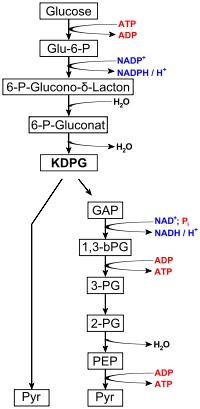Entner–Doudoroff pathway

The Entner–Doudoroff pathway (ED pathway) describes a pathway—a series of enzyme-catalyzed chemical reactions— that are active in bacterial primary metabolism, a pathway that catabolizes glucose to pyruvic acid using enzymes distinct either from those used in glycolysis or the pentose phosphate pathway (the latter two being most widely used in the Bacteria). The ED pathway was first reported by Michael Doudoroff and Nathan Entner from the Bacteriology Department at the University of California, Berkeley in 1952.[1] Recent work on the Entner-Duodoroff pathway has shown that its use is not restricted to prokaryotes as was previously thought. Specifically, there is direct evidence that Hordeum vulgare utilizes the Entner-Duodoroff pathway.[2] Use of the Entner Duodoroff pathway among other plants such as mosses and ferns is also probably widespread based on preliminary sequencing data analysis.[2]
Distinct features of the Entner–Doudoroff pathway are that it:
- Uses 6-phosphogluconate dehydratase and 2-keto-3-deoxyphosphogluconate aldolase to create pyruvate from glucose.
- Has a net yield of 1 ATP for every one glucose molecule processed, as well as 1 NADH and 1 NADPH. In comparison, glycolysis has a net yield of 2 ATP molecules and 2 NADH molecules for every one glucose molecule metabolised.
Organisms that utilize the Entner-Doudoroff pathway
There are several bacteria that utilize Entner–Doudoroff pathway for metabolism of glucose and are unable to catabolize via glycolysis (e.g., therefore lacking essential glycolytic enzymes such as phosphofructokinase as seen in Pseudomonas).[3] Genera in which the pathway is prominent include Gram-negative, as listed below, Gram-positive bacteria such as Enterococcus faecalis,[4] as well as several in the Archaea, the second distinct branch of the prokaryotes (and the "third domain of life", after the prokaryotic eubacteria and the eukaryotes).[5] Most organisms that use the pathway are aerobes, due to the low ATP yield per glucose molecule metabolised.
Examples of bacteria using the pathway are:
- Pseudomonas,[6] a genus of Gram-negative bacteria
- Azotobacter,[7] a genus of Gram-negative bacteria
- Rhizobium,[8] a plant root-associated and plant differentiation-active genus of Gram-negative bacteria
- Agrobacterium,[9] a plant pathogen (oncogenic) genus of Gram-negative bacteria, also of biotechnologic use
- Escherichia coli,[6] a Gram-negative bacterium
- Enterococcus faecalis,[10] a Gram-positive bacterium
- Zymomonas mobilis, a Gram-negative facultative anaerobe
- Xanthomonas campestris,[11] a Gram negative bacterium which uses this pathway as main pathway for providing energy.
- Hordeum vulgare, barley utilizes the Entner-Duodoroff pathway.[2]
The Entner-Doudoroff pathway is present in many species of Archaea (caveat, see following), whose metabolisms "resemble... in [their] complexity those of Bacteria and lower Eukarya," and often include both this pathway and the Embden-Meyerhof-Parnas pathway of glycolysis, except most often as unique, modified variants.[5]
Further reading
- Bräsen C.; D. Esser; B. Rauch & B. Siebers (2014) "Carbohydrate metabolism in Archaea: current insights into unusual enzymes and pathways and their regulation," Microbiol. Mol. Biol. Rev. 78(1; March), pp. 89–175, DOI 10.1128/MMBR.00041-13, see or , accessed 3 August 2015.
- Ahmed, H.; B. Tjaden; R. Hensel & B. Siebers (2004) "Embden–Meyerhof–Parnas and Entner–Doudoroff pathways in Thermoproteus tenax: metabolic parallelism or specific adaptation?," Biochem. Soc. Trans. 32(2; April 1), pp. 303–304, DOI 10.1042/bst0320303, see , accessed 3 August 2015.
- Conway T. (1992) "The Entner-Doudoroff pathway: history, physiology and molecular biology," FEMS Microbiol. Rev., 9(1; September), pp. 1–27, see , accessed 3 August 2015.
- Snyder, L., Peters, J. E., Henkin, T. M., & Champness, W. (2013). Molecular genetics of bacteria. American Society of Microbiology.
References
- ↑ Nathan Entner; Michael Doudoroff (1952). "Glucose and gluconic acid oxidation of Pseudomonas saccharophila" (PDF). J. Biol. Chem. 196: 853–862. Retrieved 3 August 2015.
- 1 2 3 Chen, Xi, et al. "The Entner–Doudoroff pathway is an overlooked glycolytic route in cyanobacteria and plants." Proceedings of the National Academy of Sciences (2016): 201521916.
- ↑ Conway,T. (1992) "The Entner-Doudorodd pathway: history, physiology and molecular biology" Microbiology of Reviews 103(19; May), pp. 1-28, DOI , see
- ↑ Willey; Sherwood; Woolverton. Prescott's Principles of Microbiology.
- 1 2 Bräsen C.; D. Esser; B. Rauch & B. Siebers (2014) "Carbohydrate metabolism in Archaea: current insights into unusual enzymes and pathways and their regulation," Microbiol. Mol. Biol. Rev. 78(1; March), pp. 89-175, DOI 10.1128/MMBR.00041-13, see or , accessed 3 August 2015.
- 1 2 Peekhaus N, Conway T (1998). "What's for dinner?: Entner-Doudoroff metabolism in Escherichia coli.". J Bacteriol. 180 (14): 3495–502. PMC 107313
 . PMID 9657988.
. PMID 9657988. - ↑ Michael P. Stephenson; Frank A. Jackson; Edwin A. Dawes (1978). "Further Observations on Carbohydrate Metabolism and its Regulation in Azotobacter beijerinckii". Journal of General Microbiology. 109 (1): 89–96. doi:10.1099/00221287.
- ↑ Kuykendall, L. David; John M. Young; Esperanza Martínez-Romero; Allen Kerr & Hiroyuka Sawada (2006) Genus I. Rhizobium Frank 1889, 389AL [Order VI. Rhizobiales ord. nov., Family I Rhizobiaceae Conn 1938, 321AL (L. David Kuykendall, Ed.)], pp. 324-339, in Bergey's Manual® of Systematic Bacteriology, Vol. 2 The Proteobacteria, Part 3 The Alpha-, Beta-, Delta-, and Epsilonproteobacteria, (Don J. Brenner, Noel R. Krieg, James T. Staley, Vol. Eds., George M. Garrity, Ed.-in-Chief), New York, NY, USA: Springer Science & Business, ISBN 0387241450, , accessed 3 August 2015.
- ↑ Arthur LO, Nakamura LK, Julian G, Bulla LA (1975). "Carbohydrate catabolism of selected strains in the genus Agrobacterium.". Appl Microbiol. 30 (5): 731–7. PMC 187263
 . PMID 128316.
. PMID 128316. - ↑ Goddard J.L.; J.R. Sokatch (1964). "2-Ketogluconate fermentation by Streptococcus faecalis.". J Bacteriol. 87: 844–851. PMC 277103
 . PMID 14137623.
. PMID 14137623. - ↑ Lu, G.T.; J.R. Xie; L. Chen; J.R. Hu; S.Q. An; H.Z. Su; et al. (2009). "Glyceraldehyde-3-phosphate dehydrogenase of Xanthomonas campestris pv. campestris is required for extracellular polysaccharide production and full virulence.". Microbiology. 155 (5): 1602–1612. doi:10.1099/mic.0.023762-0. PMID 19372163.